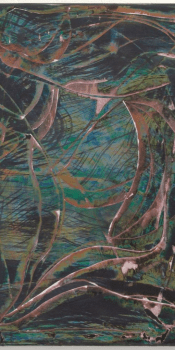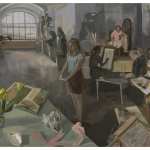Contributed by Michael Brennan / As a close follower of the emerging art core in South Brooklyn, I seldom miss an exhibition at Yi Gallery. Its shows are invariably interesting and novel, perfectly and poetically installed. The primary space is currently featuring a nicely integrated two-person show of Xingze Li and Sarah Pater’s work, with individual exhibitions for each artist in the back.
Recent Posts
Ian Myers: A painter’s faith
Contributed by Anna Gregor / Ian Myers’ paintings blur the lines between art, nature, and miracle, asking what painting’s vocation is at a moment when anything can be art, nature is under threat, and miracles are unfathomable. His five paintings, on view in his solo show “immortal flub” at New Collectors Gallery, are obviously art. Rectangles do not occur in nature, nor do the white gallery walls on which his rectangular paintings hang. But these rectangles don’t act like windows that allow us to enter an illusionistic space, as we expect from mimetic paintings. Nor do they reveal the human hand or thought processes that we assume to be involved in making abstract work. They eschew the exhibitionist gesture of Abstract Expressionism, the clarity of hard-edge abstraction, and the planned step-by-step process of much contemporary abstraction.
Farrell Brickhouse: The beat goes on
Contributed by Jonathan Stevenson / Farrell Brickhouse’s recent paintings, on view at JJ Murphy Gallery, embody aging and stamina and the grungy inventiveness that comes with them. In these terms, perhaps the signature piece is Summers End II, tucked away all by itself in the gallery’s rear alcove. Just a foot-and-a-half square, it is a still life of Rauschenberg-grade grit that holds court, depicting what looks like a vase of motley flowers on a stand, waning but defiant in the face of time. Distressed as they are, they look not just alive but capable of aggression. The work is textured in the extreme, Brickhouse having affixed to the canvas the congealed detritus of students’ pigment and painted thickly around it. It’s as though Chaïm Soutine or Frank Auerbach had possessed Morandi and gone to town.
Mary Carlson: Timelessly medieval
Contributed by Adam Simon / I happened to visit Mary Carlson’s exhibition “Garden” at Kerry Schuss Gallery the day I finished reading Titus Groan, the first of Mervyn Peake’s Gormenghast novels, written in the 1950s. I’m not usually drawn to fantasy fiction – this book was a gift – but Peake’s dreamlike rendering of a forbidding castle with clinging ivy and bizarre inhabitants had me in thrall, primed to receive Carlson’s medieval world and its symbiotic relationships between plants and people. One of the characters in Titus Groan uses the ivy to scale the castle walls, while two others take tea on a tree that grows horizontally out one of the windows. While not exactly ivy, vines fashioned from copper piping figure prominently in “Garden,”often dwarfing the mostly female glazed porcelain saints that sit on modest carved wooden shelves. The untamed power of the natural world, and humanity’s marginal presence in it, is an underlying theme in “Garden” and very like the world described by Peake.
What makes a good painting?
Contributed by David Carrier / What is the present state of painting? For as long as I have been writing art criticism, that question has been much discussed. Some critics have said painting was dead, perhaps to be replaced by Minimalist or conceptual art. Others have argued that because painting is an inherently bourgeois art form, it can continue only as long as it is politically tinged. The Milwaukee Art Museum’s show “50 Paintings” takes an essentially empirical approach to the question. Co-curators Margaret Andera and Michelle Grabner gathered mostly mid-sized recent paintings by artists well-known in the New York art world and demonstrated how varied and how good painting is today. There are abstractions by Peter Halley and Mary Heilmann, a landscape by April Gornik, and figurative paintings by Cecily Brown and Nicole Eisenman. It’s natural for a visiting critic to pick favorites. Mindful of the unhappy fate of Paris, whose judgment about which goddess was most beautiful triggered the Trojan War, I dare to name mine.
Lee Maxey: Teasing out the uneasy
Contributed by Patrick Neal / Many years ago, I saw a strange and seductive specter on a cold winter night in Troy, New York, that has haunted me to this day. Through the glass windows of a gloomily defunct department store, a neon shock of orange letters hovered in the air spelling out the word EXIST. This enigma was the work of the artist Sharon Bates, part of an installation in which she cleverly riffed on the authority of an EXIT sign, transforming an everyday sight into a glowing spiritual command. I was reminded of Bates’s sculpture while taking in Lee Maxey’s new exhibition of paintings, titled “Wait Here,” at Olympia.
Joan Thorne, painter and artist
Contributed by Vittorio Colaizzi / Some painters insist on calling themselves painters rather than artists, and it’s clear why. “Art” designates is a broad category that admits almost anything, while painting is a tradition centered on a medium. In his recent book, Duchamp’s Telegram, Thierry de Duve argues that, while Marcel Duchamp did not single-handedly invent art in general, he perceived and announced its arrival. Before that, art was inconceivable outside the context of specific media such as painting, sculpture, and architecture. Duchamp’s insight, of course, did not spell the end of painting, Rather, it gave painters the option of retreating into self-sustaining insularity or more expansively embracing how painting and other art overlapped in terms of image, touch, plane, color, space, and voice. Joan Thorne, whose recent paintings are now on view at David Richard Gallery, has taken the latter course, to impressive effect.
Eileen O’Kane Kornreich: Embracing fluidity
Contributed by Chunbum Park / A man riding a lion. A canine barking at a red painting of men’s legs. Snow White eyeballing the private parts of a man holding onto a chair. A blue queer person’s reach for blankets and pillows arrayed like clouds of a night sky. “Pleasures of Duality,” Eileen O’Kane Kornreich’s solo exhibition at The Opening Gallery in Tribeca, depicts sensuous figures embracing both sides of their identity. It is an agreeably assertive and highly effective migration away from customary gender-based psychological and aesthetic orientations.
Invitation: “BIG TOP” at Dumbo Open Studios, April 13 & 14, 2024, 1 – 6 pm
Please join us: The 2024 iteration of Dumbo Open Studios, takes place this weekend! Painter and Two Coats publisher Sharon Butler will have some new paintings on view at the Two Coats of Paint Project Space (20 Jay Street #308), and she has also organized “BIG TOP,” an exhibition of 13 talented young artists she met while teaching in the University of Connecticut’s MFA Program.
Robert Moskowitz’s visual quartet
Contributed by Natasha Sweeten / One thought I had upon seeing Robert Moskowitz: Paintings and Drawings from Four Decades at Peter Freeman Inc. was that I could’ve been satisfied to encounter only the large wall of drawings. Arranged loosely yet thoughtfully, in a reconstruction of a wall from the artist’s studio, over sixty works of mostly oil or pastel on paper hang with a kind of majestic poise, each pinned by two thumbtacks in the top corners. Every drawing a vertical, together they present our city: here the finely ridged silhouette of the Empire State Building, there the graceful curve of the Flatiron Building, and, most engrossingly, the dense parallel bars of the World Trade Center from another lifetime ago. Pared down to their essential shapes, the buildings stand resolute in all seasons and moods, whether blue on blue or gray on fleshy pink or black on emerald. Occasionally a hazy ray of moonlight catches a cloud, a hint of atmosphere wafts nearby, or active fingerprints swarm across the paper. These quieter moments play off hard edges in a way that evokes walking home alone after a night out with friends, when New York is at its most still and you feel a flutter of wonder to live in it. What I mean to say is, the wall is a love song to the city.























